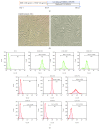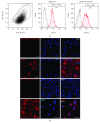Improved Efficiency of Cardiomyocyte-Like Cell Differentiation from Rat Adipose Tissue-Derived Mesenchymal Stem Cells with a Directed Differentiation Protocol
- PMID: 31065283
- PMCID: PMC6466858
- DOI: 10.1155/2019/8940365
Improved Efficiency of Cardiomyocyte-Like Cell Differentiation from Rat Adipose Tissue-Derived Mesenchymal Stem Cells with a Directed Differentiation Protocol
Abstract
Cell-based therapy has become a resource for the treatment of cardiovascular diseases; however, there are some conundrums to achieve. In vitro cardiomyocyte generation could be a solution for scaling options in clinical applications. Variability on cardiac differentiation in previously reported studies from adipose tissue-derived mesenchymal stem cells (ASCs) and the lack of measuring of the cardiomyocyte differentiation efficiency motivate the present study. Here, we improved the ASC-derived cardiomyocyte-like cell differentiation efficiency with a directed cardiomyocyte differentiation protocol: BMP-4 + VEGF (days 0-4) followed by a methylcellulose-based medium with cytokines (IL-6 and IL-3) (days 5-21). Cultures treated with the directed cardiomyocyte differentiation protocol showed cardiac-like cells and "rosette-like structures" from day 7. The percentage of cardiac troponin T- (cTnT-) positive cells was evaluated by flow cytometry to assess the cardiomyocyte differentiation efficiency in a quantitative manner. ASCs treated with the directed cardiomyocyte differentiation protocol obtained a differentiation efficiency of up to 44.03% (39.96%±3.78) at day 15 without any enrichment step. Also, at day 21 we observed by immunofluorescence the positive expression of early, late, and cardiac maturation differentiation markers (Gata-4, cTnT, cardiac myosin heavy chain (MyH), and the sarcoplasmic/endoplasmic reticulum Ca2+ ATPase (SERCa2)) in cultures treated with the directed cardiomyocyte differentiation protocol. Unlike other protocols, the use of critical factors of embryonic cardiomyogenesis coupled with a methylcellulose-based medium containing previously reported cardiogenic cytokines (IL-6 and IL-3) seems to be favorable for in vitro cardiomyocyte generation. This novel efficient culture protocol makes ASC-derived cardiac differentiation more efficient. Further investigation is needed to identify an ASC-derived cardiomyocyte surface marker for cardiac enrichment.
Figures










References
LinkOut - more resources
Full Text Sources
Research Materials
Miscellaneous

